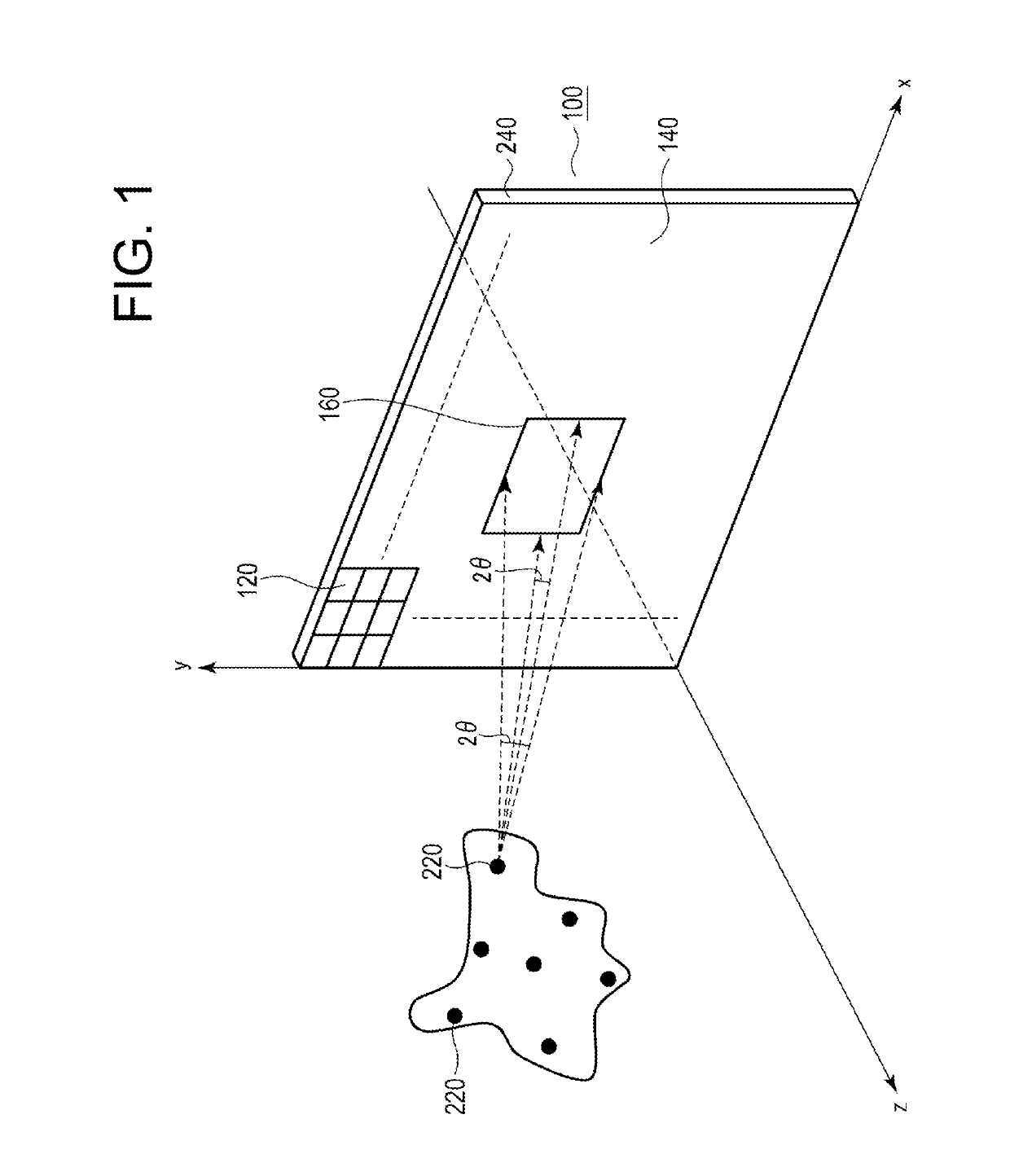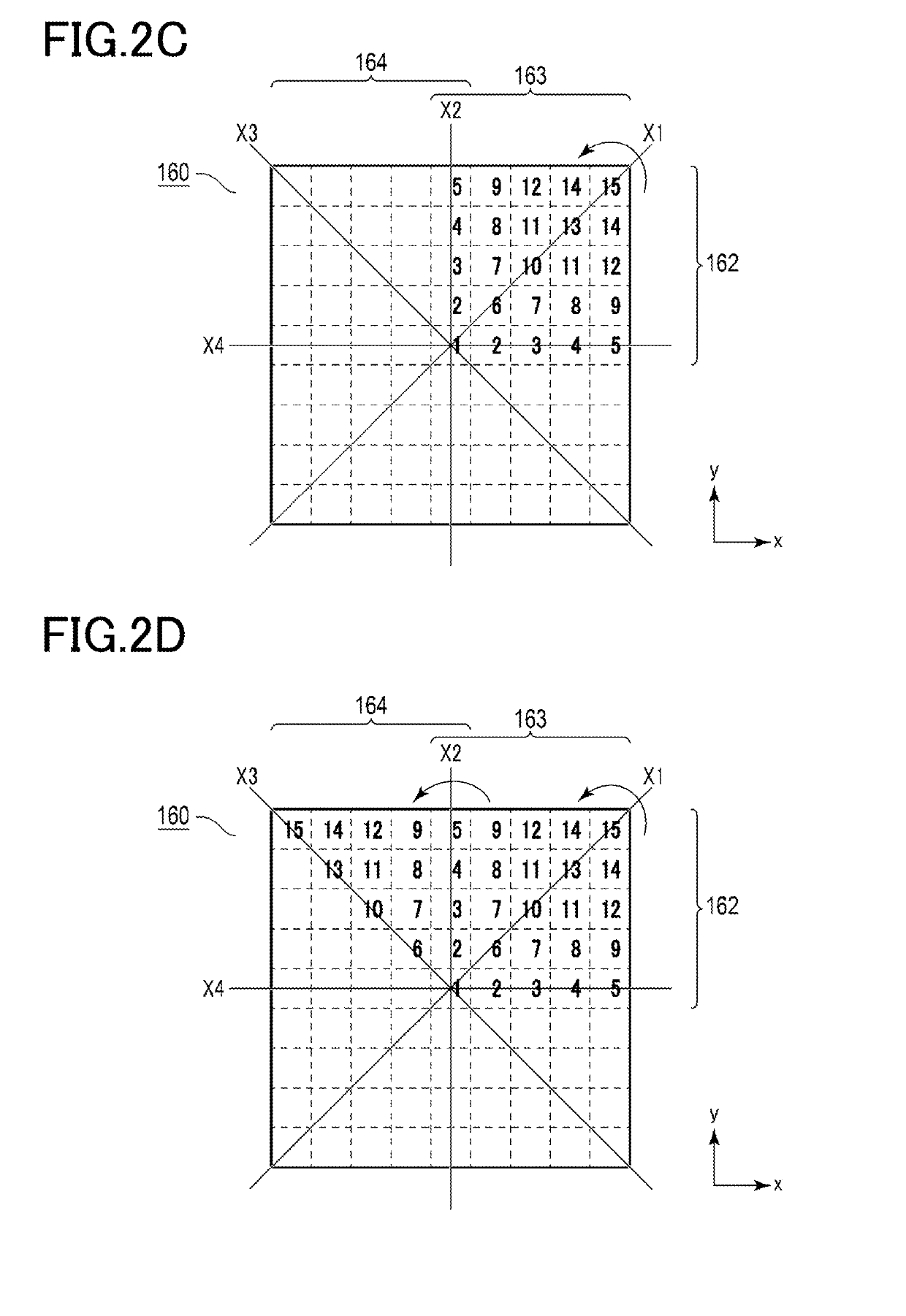Calculation method, recording method, optical film, and phase modulation structure
a recording method and phase modulation technology, applied in the direction of hologram nature/properties, optical radiation measurement, instruments, etc., can solve the problems of reducing calculation time, limiting the angle at which the original image is reconstructed, and large amount of time required, so as to reduce calculation time and reduce calculation time. , the effect of reducing the calculation tim
- Summary
- Abstract
- Description
- Claims
- Application Information
AI Technical Summary
Benefits of technology
Problems solved by technology
Method used
Image
Examples
first embodiment
[0076]FIG. 1 is a diagram illustrating an optical film according to a first embodiment of the present disclosure.
[0077]An optical film 100 of the present embodiment includes a recording surface 140 formed of a plurality of unit blocks 120 arranged in a grid pattern on an x-y plane. The recording surface 140 corresponds to a surface of a phase modulation structure 240. The recording surface 140 defines calculated element regions 160 thereon according to viewing angles θ from respective reconstruction points 220 at which an image is reconstructed
[0078]In each calculated element region 160, a plurality of unit blocks 120 are arranged. Phases of light from the corresponding reconstruction point 220 are calculated in conformity with the locations of the unit blocks 120 in the calculated element region 160 and the calculated phases are used as a basis for calculating phase angles, for recordation in the respective unit blocks. Thus, the calculated element region 160 can be a phase-recordi...
second embodiment
[0118]An optical film according to a second embodiment will be described. In the following description, components having functions identical with or similar to those of the first embodiment are denoted by the same reference signs throughout the drawings to omit duplicate description.
[0119]As described in the first embodiment, numerical information of phase angles ϕ, as data 1 to 15, are recorded in the unit blocks 120. In an optical film 100 of the present embodiment, asperity heights conforming to the phase angles ϕ are reconstructed in the corresponding unit blocks 120, instead of recording numerical information of the phase angles ϕ in the unit blocks 120.
[0120]FIGS. 9A to 9B each show a cross-sectional view of unit blocks 120 in which asperities conforming to phase angles ϕ are formed.
[0121]When converting each phase angle ϕ into an asperity height, the computer calculates the phase angle ϕ in the range of 0π to 2π, and converts the resultant value into an 8-bit grayscale value...
third embodiment
[0147]An optical film according to a third embodiment will be described. In the following description, components having functions identical with or similar to those of the first embodiment are denoted by the same reference signs throughout the drawings to omit duplicate description.
[0148]As described in the first embodiment, numerical information of corresponding phase angles ϕ is recorded in the unit blocks 120. In an optical film 100 of the present embodiment, the computer converts a variation of each phase angle ϕ into a variation in terms of a refractive index of the recording surface 140, instead of recording numerical information of the phase angle ϕ. Furthermore, the computer converts the variation of refractive index into a void realizing the variation. Then, this void 230 is embedded, as shown in FIG. 13, in the substrate 110 at a site of the corresponding unit block 120 to record the phase angle ϕ in the unit block 120.
[0149]As described above, the optical film 100 of the...
PUM
 Login to View More
Login to View More Abstract
Description
Claims
Application Information
 Login to View More
Login to View More - R&D
- Intellectual Property
- Life Sciences
- Materials
- Tech Scout
- Unparalleled Data Quality
- Higher Quality Content
- 60% Fewer Hallucinations
Browse by: Latest US Patents, China's latest patents, Technical Efficacy Thesaurus, Application Domain, Technology Topic, Popular Technical Reports.
© 2025 PatSnap. All rights reserved.Legal|Privacy policy|Modern Slavery Act Transparency Statement|Sitemap|About US| Contact US: help@patsnap.com



